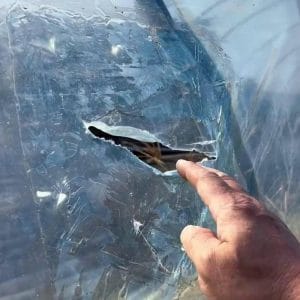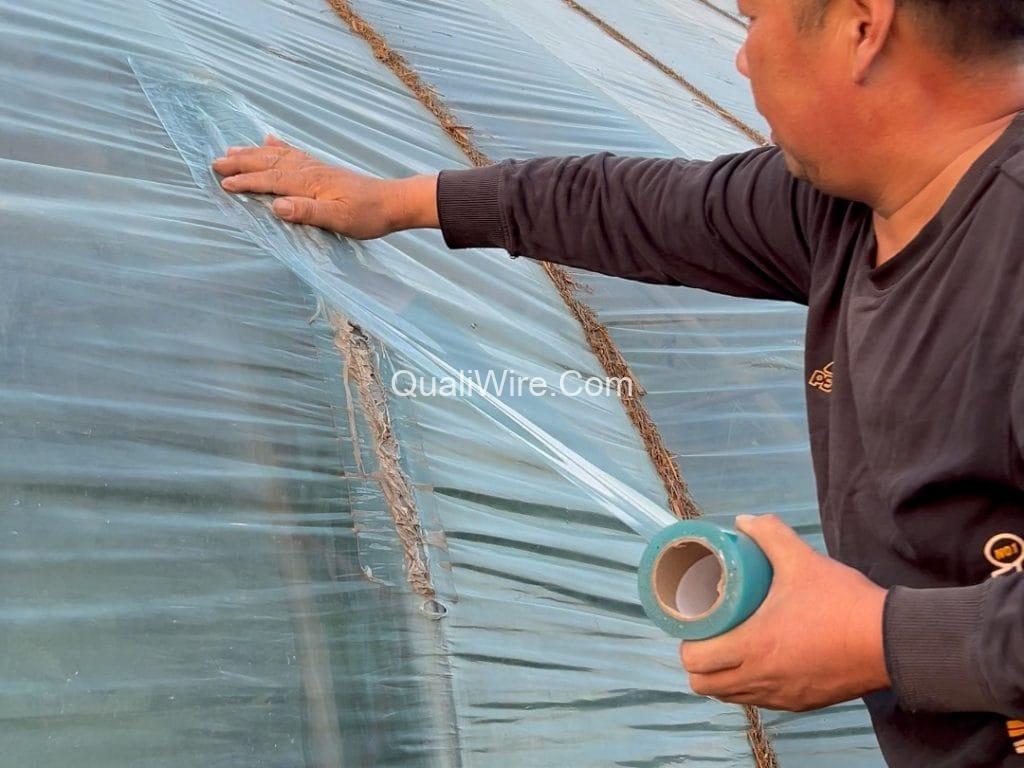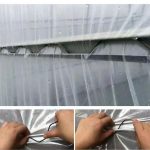How to Repair a Torn Greenhouse Plastic Film

Repairing a torn greenhouse plastic film with greenhouse film repair tape is a convenient and highly sealable method. It ensures effective windproofing, waterproofing, and heat retention after repair when following the workflow of “cleaning and prepping → precise tape cutting → layered application and pressing → seal inspection”. Below is the detailed operation guide on how to Repair a Torn Greenhouse Plastic Film:
Learning how to Repair a Torn Greenhouse Plastic Film can save time and money.
I. Pre-Repair Preparation: Tools & Environmental Requirements
How to Repair a Torn Greenhouse Plastic Film Effectively
To effectively Repair a Torn Greenhouse Plastic Film, follow these guidelines carefully.
Before starting, ensure all tools are ready and the environment is suitable to avoid impurities affecting the tape’s adhesion.
Required Tools
- Core Tool: Greenhouse film repair tape compatible with your film material (prioritize PE/PVC-specific tape with a thickness of 0.1–0.2mm). Choose a width (5cm/10cm/15cm) based on the tear size—for long tears, wider tape is recommended to minimize splicing.
- Clean, lint-free cloth (to wipe the film surface).
- Sharp scissors (to cut tape without fraying edges).
- Tape measure (optional, for measuring the tear size).
Environmental Requirements
Operate on a windless, sunny day (optimal temperature: 5–30°C). Avoid rainy, foggy days (moisture on the film reduces tape adhesion) or windy days (film movement and impurity buildup may occur).
II. Step-by-Step Repair Process: 4 Steps for Tight Adhesion
Step 1: Clean the Tear and Surrounding Film (Critical Pre-Requisite)
- If the greenhouse film is still taut, loosen it slightly (e.g., adjust the film-pressing ropes on the greenhouse frame) to prevent tape cracking due to tension during repair.
- Use a clean cloth (dampened with a little water and wrung out if needed) to wipe the film surface 10–15cm on both sides of the tear. Remove all dust, dirt, dew, and oil—impurities will prevent the tape from bonding tightly to the film, leading to air/water leakage later.
- Allow the film to dry completely (use a dry cloth to wipe it again or let it air-dry for 5–10 minutes) to ensure no moisture remains.
Make sure you have everything ready before you Repair a Torn Greenhouse Plastic Film.
It is crucial to know how to properly Repair a Torn Greenhouse Plastic Film to ensure lasting results.
Step 2: Cut the Repair Tape (Match the Tear Size)
- Measure the tear’s length and width. For irregularly shaped tears, calculate based on the “maximum length + 2cm” and “maximum width + 2cm” to leave a “edge allowance” (prevents unprotected tear edges).
- Cut the tape with scissors:
- The tape length should be 3–5cm longer than the tear (extend 1.5–2.5cm on both ends for better durability).
- The tape width should cover 2–3cm on both sides of the tear (e.g., a 1cm-wide tear requires tape of at least 5cm in width).
- For long tears (over 1m), cut a single piece of tape instead of splicing multiple pieces (spliced areas are prone to gaps). For cross-shaped tears, first apply horizontal tape, then vertical tape, with an overlap of over 5cm at the intersection.
Step 3: Apply the Tape in Layers, Focus on Pressing the Edges
- Position and Peel the Liner: Align the cut tape with the tear, ensuring the tape’s center matches the tear’s center and the reserved width is even on both sides. Hold one end of the tape to fix its position, then slowly peel off the tape’s release liner (some tapes are “liner-free self-adhesive”—simply remove the protective film).
- Apply from the Center to the Sides: First attach the center of the tape to the center of the tear and press gently to fix it (avoid starting from the edges, which may cause wrinkles in the middle). Then use your palm or a scraper (a flat piece of cardboard works if no scraper is available) to press slowly from the center to the sides, expelling air between the tape and the film (trapped air causes bubbling and future peeling).
- Reinforce Edge Pressing: After application, repeatedly press the four edges of the tape (especially the parts extending beyond the tear) with your fingers or a scraper. Ensure no edges lift or gaps remain—edges are critical for sealing; unpressurized edges allow rainwater to seep in and damage the tape.

Step 4: Inspect the Repair Effect & Handle Special Cases
- Let the tape sit for 10–20 minutes (to fully activate its adhesion), then gently pull the tape edges to check if it is secure.
- If there are slight wrinkles at the tear, use a scraper to press from the wrinkle toward the edge again to expel air. For severe wrinkles, peel off the tape and reapply (avoid forcing flattening, which may damage the film).
- For large tears (over 5cm wide) or thick films, use a “double-sided application” method: First apply one layer of tape to the front of the film, then flip to the back, align with the tear, and apply a second layer. Ensure the two layers overlap by over 2cm to enhance repair strength.
III. Post-Repair Notes: Extend Service Life
- Avoid Immediate Stress: Do not pull, press, or readjust the greenhouse film’s tension within 24 hours of repair—this prevents tape displacement.
- Regular Inspection and Maintenance: Check the repaired area every 1–2 weeks. If tape edges lift, press them with a scraper promptly; if the tape is damaged, replace it with new tape immediately.
- Extreme Weather Protection: Before heavy rain or strong winds, add an extra layer of narrow tape (3cm wide) over the repaired area to improve wind and water resistance. In low winter temperatures, if the tape’s adhesion decreases, gently heat the tape surface with a warm towel (temperature ≤40°C) before pressing to enhance adhesion (avoid high temperatures that may melt the film).
Following these steps, greenhouse film repair tape enables quick and effective tear fixes. The repaired area will have sufficient sealing and durability to meet daily greenhouse needs. Compared to sewing (prone to holes) or glue (may corrode the film), tape repair is better suited to greenhouse film properties and offers the highest cost-effectiveness.
After applying the tape, assess if you need to Repair a Torn Greenhouse Plastic Film further.
Finally, ensure your repair is robust and ready for any weather by learning how to Repair a Torn Greenhouse Plastic Film.
Understanding how to Repair a Torn Greenhouse Plastic Film will help extend your greenhouse’s life.
In conclusion, knowing how to Repair a Torn Greenhouse Plastic Film is essential for every greenhouse owner.





Comments are Closed